on Euro Emissions, Additive, ADAS, & Many More Auto Advances
Chinese EVs in Paris. . .Euro Emissions. . .Additive for Tire Design. . .Conti Car Tech for Construction. . .Sensor-visible Fabric. . .Lucid Adds Accessories. . .VW EV and Drones. . .WRX considered
#regulations
Two Disturbing Things Regarding Europe
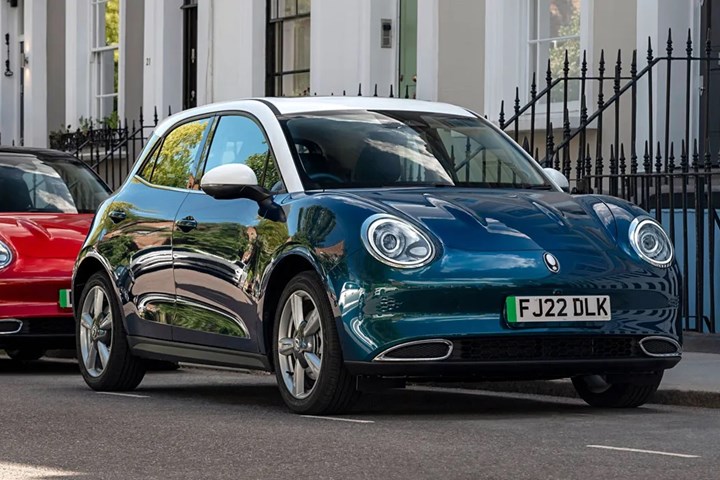
The Ora Funky Cat EV. (Image: Great Wall Motors)
- The production forecast for Germany has it that whereas there were some 5-million passenger cars and light commercial vehicles produced in the country in 2019, analysis firm Inovev expects annual production between 2024 and 2030 to be no more than four million. A 20% decline.
- In its coverage of the Paris Motor Show—and know that Inovev is based in Paris—the company observed: “this year the Chinese manufacturers”—BYD, Ora, Wey, Seres and XEV—“have made a special effort to be present at the Paris Motor Show, while the German, Japanese and Korean manufacturers have preferred not to be present.” Know that Chinese electric vehicles and hybrids are available on the Euro market.* While the absence of some European and Asian OEMs may not hurt their sales, it most certainly won’t help.
==
*In an analysis of China Light Vehicle sales, LMC Automotive wrote that “new energy vehicles” (NEVs), full EVs and plug-in hybrids, had sales of 6.57 million in September (the most recent month of reporting), or 26.5% of the total passenger vehicle market.
And there’s more:
“Not only is there strong domestic buying enthusiasm, but exports are also a significant part of NEV wholesales and production growth. In 2022, China's auto exports have so far showed an explosive growth trend. This is mainly due to the shortage of overseas supply and the substantial enhancement of the export competitiveness of Chinese OEMs, leading to a substantial export opportunity for Chinese cars. NEVs make up the core growth in China's automobile exports, with Chinese NEVs being mainly exported to Western Europe and Southeast Asian markets.”
Odds are, that export effort will not diminish but only grow.
///
Euro Auto Emissions
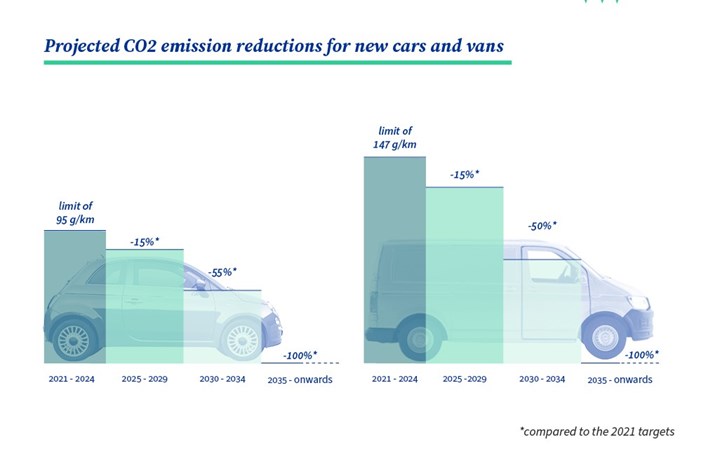
The changes that are occurring in the EU vis-à-vis emissions. (Image: European Council, Council of the European Union)
While on the subject of the auto industry in the European Union. . .
It:
- Accounts for more than 7% of the GDP
- Represents 6.6% of all employment (12.7 million jobs)
- Is second in production volume in the world, behind China
- Accounts for 34% of all R&D in the EU, making it the biggest sector
That according to the European Council, Council of the European Union.
And last week, that organization announced, “The Council and the European Parliament reached a provisional political agreement on stricter CO2 emission performance standards for new cars and vans. . . .
“Pending a formal adoption, the co-legislators agreed to a:
- 55% CO2 emission reduction target for new cars and 50% for new vans by 2030 compared to 2021 levels
- 100% CO2 emission reduction target for both new cars and vans by 2035.”
Yes, that would mean the internal combustion engine would be at risk for market irrelevance.
Not eliminated?
Well, there’s this:
“The agreement includes wording on CO2 neutral fuels whereby following consultation with stakeholders, the Commission will make a proposal for registering vehicles running exclusively on CO2-neutral fuels after 2035 in conformity with EU law, outside the scope of the fleet standards, and in conformity with the EU’s climate neutrality objective.”
And assuming that the “formal adoption” occurs, which is, reports have it, likely, there is a bit of wiggle room for the European OEMs:
“The agreement includes a review clause that will ensure that in 2026, the Commission thoroughly assess the progress made towards achieving the 100% emission reduction targets and the need to review these targets taking into account technological developments, including with regard to plug-in hybrid technologies and the importance of a viable and socially equitable transition towards zero emissions.”
This could be a way for the OEMs to get an extension. . .or have the opposite effect should some other OEMs, say those based in China (see previous item), show that there is a “viable and socially equitable” way to get to zero emissions, which presumably means technologically feasible and affordable.
Pay Up
And there’s another way that a recalcitrant OEM could keep building ICEs for the market:
“Manufacturers can continue to place vehicles with combustion engines on the market”—wait for it—“but if they exceed their emissions target in a given year, they must pay a premium of €95 per gram CO2/km above the target per vehicle registered.”
Some quick math: say a given vehicle is off by five grams and the OEM sells 25,000 of them. That’s 95 x 5 = 475; 475 x 25,000 = 11,875,000. Nearly 12 million Euros.
The Council, perhaps with a bit of economic gallows humor, points out:
“Consequently, with the new targets agreed, zero-emission vehicles will eventually become cheaper than vehicles running on fossil fuels.”
Certainly cheaper for the OEMs than paying potentially massive fines.
///
Additive for Autonomous
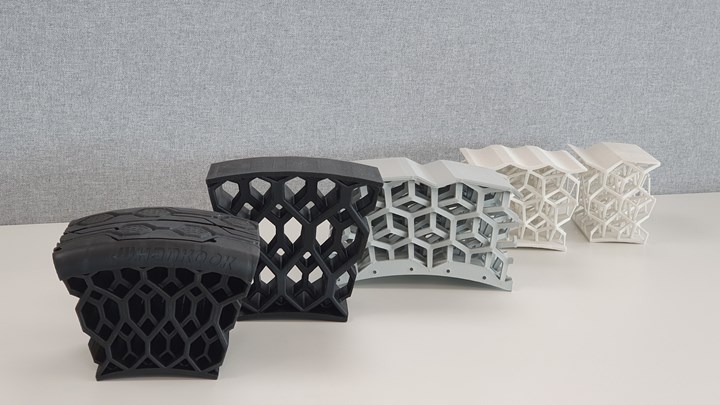
Using additive to create nonpneumatic tires for autonomous applications. (Image: Hankook/3D Systems)
Assuming that autonomous vehicles will be initially operated in commercial service settings (i.e., picking up and dropping off people) rather than be owned individually, there is one thing that needs to be kept in mind:
A flat tire would be exceedingly inconvenient.
(Not that flat tires aren’t always inconvenient, but it would be more troubling when you’re in a commercial vehicle and have to wait for someone to come fix it or for a replacement vehicle to arrive.)
Hankook Tire & Technology is working on nonpneumatic tire (NPT) designs.
Biomimicry
Tire designers decided that a biomorphic design would be the way to go for the structure of the tire. But given the number of possibilities in this space, traditional prototyping was deemed not appropriate because (a) it was time consuming and expensive and (b) some of the forms simply didn’t lend themselves to machining.
“Additive manufacturing does not have these limits,” said Hee Sung Jang, Design Innovation Studio Designer, Hankook Tire & Technology.
So needless to say they used additive.
Hankook used Figure 4 equipment and materials from 3D Systems for producing the bio structures and rubber tread and worked with CP Tech that performed selective laser sintering for the metal structure and hinges that are part of the i-Flex prototype tires.
The models are used in a variety of test scenarios, from structural to acoustic.
///
Digital Tech for Construction

Continental is bringing tech more generally associated with passenger vehicles to construction sites. (Image: Continental)
Car tech on construction sites?
This is an approach that Continental is taking.
Philip Nelles, CEO of Continental’s ContiTech group sector, says, “We want to help shape tomorrow construction industry today.”
One example is the ProViu 360 digital surround view system that has been adapted from light vehicles to construction equipment. The heavy-duty version includes software features like Worker Detection, which allows people in close proximity to the construction machine to be discerned and the operator to be warned.
There’s the Digital Guardian Angel, again adapted from road traffic applications. Here people, machines and vehicles communicate with one another via smartphones or telematics systems to prevent accidents.
Tires, Too
Conti, through its tire business, is certainly familiar with tire pressure monitoring systems, which have been required for passenger car applications since September 1, 2007.
For construction applications there is ContiConnect 2.0. It is a digital tire management system. Drivers are warned if, for example, the air pressure is too low or there is the potential of overheating.
Given the size—and cost—of those tires, knowing conditions are critical for safe—and cost-effective—operations.
Comparatively speaking, the number of earth-moving and construction-related vehicles is small compared to passenger vehicles and commercial trucks.
However, gaining scale is always a good thing for amortizing the cost of technology development.
///
Evidently Protective
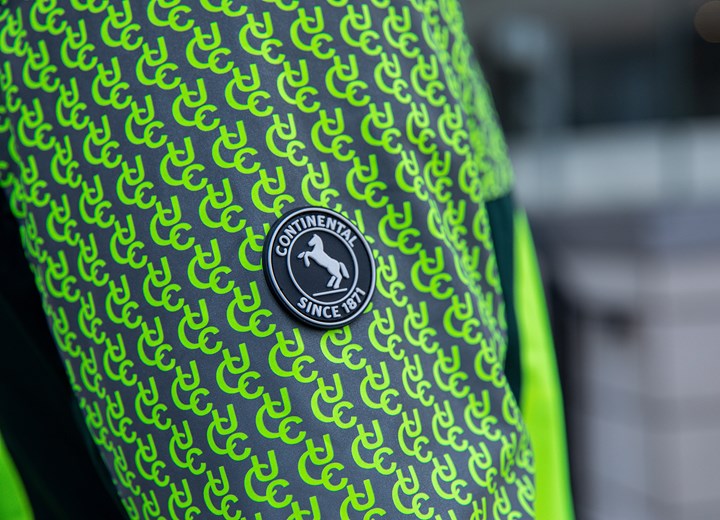
Jacket material optimized for detection by ADAS sensors. (Image: Continental)
While on the subject of Continental and advanced tech. . .
“Our ‘Vision Zero’—zero fatalities, zero injuries, zero crashes—not only includes automobile users, but also focuses especially on vulnerable road users,” says Eric Vincelot, head of Continental Engineering Services France.
These vulnerable road users include bicyclists and pedestrians.
So, how to come up with something to protect them?
By collaborating with Urban Circus, a French outdoor wear company.
The result: The Detectable Jacket.
The jacket is made with Urban-RPrint technology fabric that has a designed arrangement of fluorescent and reflective fabric inserts.
The benefit: The jacket is highly visible to both vehicle on-board camera and LIDAR systems.
The inserts are positioned so the sensors can detect the silhouette of the person.
The fabric is coated with thousands of glass microbeads. That allows the jacket to reflect light from headlights 300 meters away.
It is said to be twice as reflective as conventional high-visibility vests.
And there is another benefit to the jacket: It is waterproof.
///
Lucid Adds Accessories
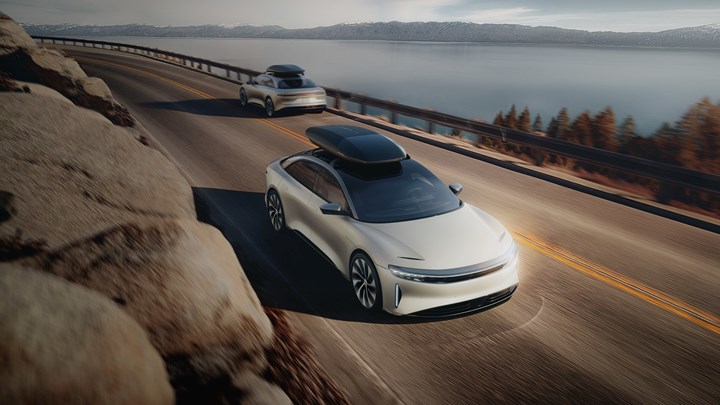
Lucid designers and engineers developed the roof-top cargo container specifically for the Air. (Image: Lucid Motors)
There are two reasons (probably more, but we’ll stick with two) why OEMs are in the accessories business:
- There’s little point in having another company making money on products that are tailored to a vehicle the OEM has produced
- There is likely a more congruent design approach to those accessories when executed by the OEM
This has long been something the traditional OEMs have been doing.
But you can buy objects ranging from a pet liner to center console trays (and more) for a Tesla Model 3.
Lucid Gear
Now Lucid Motors has entered the arena.
The company emphasizes that its in-house design and engineering personnel have worked on the accessories.
There’s an at-home charging station—that can deliver up to 19.2 kW, which translates to providing a Lucid Air with 80 miles of range per hour of charging. It is described as being “in an elegant black casing.”
What’s more interesting is that this is positioned as “the first offering to support Lucid customers looking to integrate their vehicle into the company’s future energy ecosystem.”
The Lucid Air Cargo Capsule, produced with a sleek black ABS shell, provides 11.47 cubic feet of cargo capacity. Given that the car has a coefficient of drag of just 0.21 you know that they made this container as sleek as possible.
And Don’t Forget. . .
And, of course, there are mats. Again, designed in house.
The three-piece set retails for $250.
For a car that starts at $87,400, you’d imagine they’d throw those in.
///
TVA and VoA; EVs and Drones
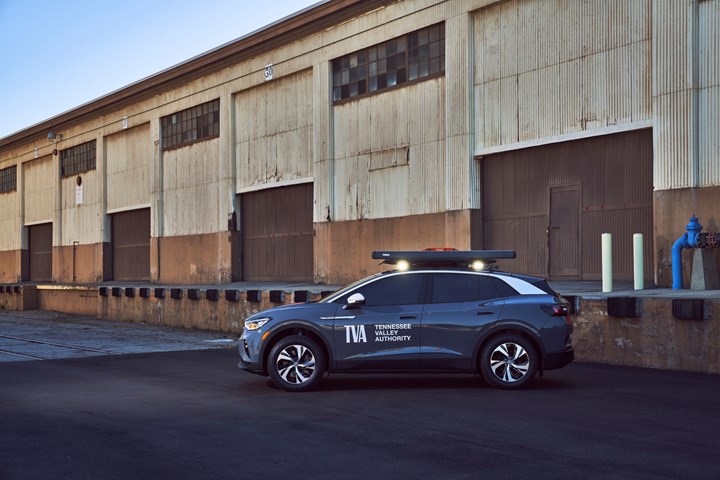
Volkswagen of America and the Tennessee Valley Authority are running a test on EV use. This ID.4 is setup with a drone platform on its roof. (Image: Volkswagen of America)
And while on the subject of putting things on a roof. . .
The Tennessee Valley Authority (TVA) has a goal of having a 100% electric sedan and SUV fleet by 2030.
It so happens that there is a company that is producing electric vehicles in Tennessee: Volkswagen of America (VoA) in its facility in Chattanooga.
Now wanting to make sure that this EV transformation will work as expected, the TVA and VW are collaborating on a year-long test with ID.4s.
One of the SUVs, a 2023 ID.4 AWD Pro S, has been configured as a “Mobile Drone Response Vehicle.”
There is a Thule Caprock platform roof rack placed on the top. In the back below the hatch there is a custom storage unit to transport the drone and associated equipment and a portable power unit.
There’s a heavy-duty suspension added to accommodate the hauling of addition equipment. There is also an array of lighting.
Not surprisingly, Volkswagen has the drone response vehicle in its display at the Specialty Equipment Market Association (SEMA) Show in Las Vegas this week.
///
2022 Subaru WRX Limited
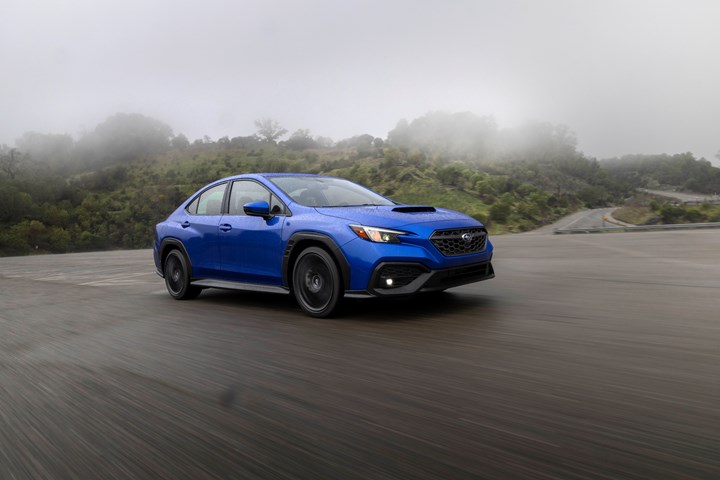
You could slalom your way to a supermarket in this WRX. (Image: Subaru)
Presumably the pandemic caused people to want to get more out “in nature,” which has led to the phenomenon of an increased interest in off-road vehicles.
Arguably it has also had an effect on those who want to drive, as in actually participating in the activity rather than it merely being whatever it is that one is doing between sending texts.
This has led to an interest in rally-type vehicles.
Authenticity
And possibly paramount among them for people who are looking for something that has a pedigree such that when they go out on roads that may or may not be closed to the public they have vehicular cred if the choice they make is for the 2022 Subaru WRX as this new model represents the fifth generation.
Yes, authenticity.
Numbers
The car is powered by a 271-hp, 2.4-liter turbocharged engine that produces 258 lb-ft of torque at from 2,000 to 5,200 rpm. There is up to 12 psi of boost.
The vehicle, in all trim grades (WRX, Premium and Limited), has a six-speed manual as standard (except for the GT, for which the Subaru Performance Transmission, an automatic, is standard), so again, the manual goes to the point of well-engaged driving (i.e., unless you are particularly dexterous, it is tough to shift and text at the same time).
BUT (yes, a big but) most people spend the significant portion of their time behind the wheel in conditions that aren’t particularly demanding of the standard all-wheel drive. Yes, the dual-pinion electric power steering certainly helps when throwing the car into that tight turn, but it also helps in a parking lot.
And so having the amenities of a daily-driver is something that is certainly important because unless one can afford to use the WRX as a weekend-only vehicle, there is that regular time behind the wheel.
To that end, the Limited version includes such things as a 10-way power driver seat that’s covered with Ultrasuede; automatic climate control with voice-activated control; an 11.6-inch multimedia touchscreen; 11-speaker Harmon Kardon system; power moonroof; and other amenities that make the commute comfortable.
However. . . “comfortable” is a relative thing. Given the nature of the vehicle, it has a decidedly stiffer ride than your average sedan, crossover or whatever else it is that you may be familiar with (unless, of course, you have a WRX or comparable vehicle). You are going to feel the ride to the grocery store.
Also
Of course, there are also things like 18-inch alloy wheels, aluminum-alloy pedal covers and a low-profile trunk spoiler, so even Limited has the sauce.
This model has an MSRP of $35,995. The base WRX is at $29,105 and the top-of-the-line GT at $41,895. So WRX has a good range for those who are looking for a little enthusiastic driving in their lives.
~~~
RELATED CONTENT
-
Honda to Make Hybrids in Thailand
Honda Motor Co. is preparing to launch production in Thailand of hybrid cars and the batteries that help power them.
-
On Ford Maverick, Toyota Tundra Hybrid, and GM's Factory Footprint
GM is transforming its approach to the auto market—and its factories. Ford builds a small truck for the urban market. Toyota builds a full-size pickup and uses a hybrid instead of a diesel. And Faurecia thinks that hydrogen is where the industry is going.
-
Special Report: Toyota & Issues Electric
Although Toyota’s focus on hybrid powertrains at the seeming expense of the development of a portfolio of full battery electric vehicles (BEVs) for the market could cause some concern among those of an environmental orientation, in that Toyota doesn’t seem to be sufficiently supportive of the environment, in their estimation. Here’s something that could cause a reconsideration of that point of view.


.jpg;width=70;height=70;mode=crop)






